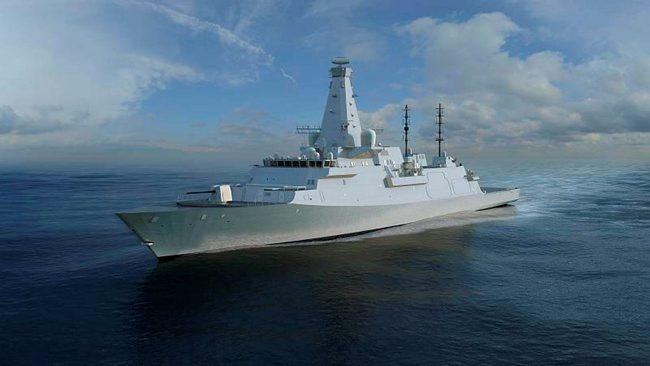UK Type 26 frigate: a cruiser by any other name?
Posted By Philip Radford on August 9, 2016 @ 06:00

Are modern-day frigates really cruisers, or is it just that the present-day needs of a frigate require the 6,000-plus tonnage of an old-fashioned cruiser? Alastair Cooper [1] exchanged a polite broadside with ASPI’s Andrew Davies [2] on the topic in April, arguing that form follows function: regardless of tonnage, frigates aren’t designed to ‘take a command [of a force of ships] in a least one warfare discipline‘. Frigates will stay frigates, no matter how big they get.
This isn’t an arcane topic, especially as the topmasts of Australia’s own SEA 5000 frigate [3] appear over the procurement horizon. That’s because the pace of evolution in naval capability is accelerating, with unmanned vehicles, modularity, new systems architectures, and adaptable weapons creating a highly fluid relationship between a naval vessel type and the tasks it can theoretically perform.
To see how naval architects are navigating these uncertain waters, it’s worth surveying some of the design principles behind the UK’s Type 26 Global Combat Ship [4] (GSC). This isn’t just because it’s one of the three contenders for SEA 5000, but also because it’s the last to leave the drawing board—or at least the 3-D CAD studio.
Two aspects of the Type 26 stand out immediately. First, it has a large, multi-purpose mission bay forward of the aircraft hangar; at approximately 385m3, it’s the equivalent volume of ten 20-foot shipping containers. Secondly, the vessels have a ‘shared infrastructure’ approach to combat systems. Both these design features are definite breaks in the path of frigate evolution. They also support Davies’ thesis that frigates are evolving into cruisers ‘in form as well as function’—albeit in a curious way.
The mission bay allows the frigate to assume far more advanced roles than those to which a traditional escort could aspire. For example, Cooper correctly points out that a traditional frigate couldn’t properly perform the command function required by a large task force. But a palletised command and control centre lifted on board results in a vessel that can command highly complex, multi-vessel or amphibious operations.
Similarly with unmanned vehicles (UVs). Type 26 designers envisage that unmanned submarine, surface and air vehicle systems will operate from the mission bay, with a deck-mounted crane to launch and retrieve 12-tonne vehicles from the sea. Since the bay includes network interfaces, self-contained UV systems can be plugged straight into the ships power and command networks. Designers envisage aircraft being launched from the mission bay’s side-door openings.
The point here isn’t detail of the Type 26 design, but the fact that frigate designers are deliberately creating vessels that can supplement their primary role with advanced, fleet-managing capabilities in a way never envisaged before. As long as the capability can be modularised, flown into position and placed on a quay, the vessel can take on the independent, specialised or fleet-leading roles—in short, the roles historically associated with cruisers.
The second Type 26 feature of note is its systems architecture. It’s often said that cars are becoming computers on wheels, and warships aren’t exactly wallowing in their wake. Until now, most naval systems have been discreet physical entities. From a sensor on the mast, to a display in the operations room, a naval system used its own dedicated hardware, software and wiring.
The Type 26 designers have shifted to a shared infrastructure model, so servers, networks and consoles are independent of specific naval systems. Data from new sensors can be incorporated into the operations room with little of the physical and technical disruption required by the back-fitting of consoles, networks and hardware. In practical terms, it means freedom and flexibility in how tactical information is disseminated and worked with by the crew.
It’s probably because the Type 26 has morphed into an ‘adaptive cruiser’ role that the Royal Navy has—after a decade of agonising—split its frigate purchase between eight Type 26s, and an indefinite number of smaller general purpose frigates (GPFFs). On that count alone, the Type 26 deserves a nomenclatural promotion, especially when you review the impressive radar, missile and gunnery specs of GPFF contenders.
The ability for major fleet units to quickly adapt to different roles creates fascinating opportunities. It also poses challenges, as Australian Defence planners ponder the construction of up to 20 new offshore combatant vessels [5] (OCVs) of up to 2,000 tonnes each. A rigid, form-follows-function philosophy in naval design will lead to a fleet of vessels that are hopelessly ill-equipped to adapt, and can’t adopt innovative modes of combat.
Technologically, we live in exciting times. If, instead of working backwards from function to hull form, Defence can work forward from hull form to potential capabilities, then the way is clear for rich and original thought in Australia’s naval program.
Article printed from The Strategist: https://aspistrategist.ru
URL to article: /uk-type-26-frigate-cruiser-another-name/
URLs in this post:
[1] Alastair Cooper: https://aspistrategist.ru/form-follows-function/
[2] Andrew Davies: https://aspistrategist.ru/the-expanding-of-the-shrew/
[3] SEA 5000 frigate: https://aspistrategist.ru/sea-state-future-frigate-contenders/
[4] 26 Global Combat Ship: https://en.wikipedia.org/wiki/Global_Combat_Ship
[5] offshore combatant vessels: https://en.wikipedia.org/wiki/Planned_Australian_offshore_combatant_vessel
Click here to print.